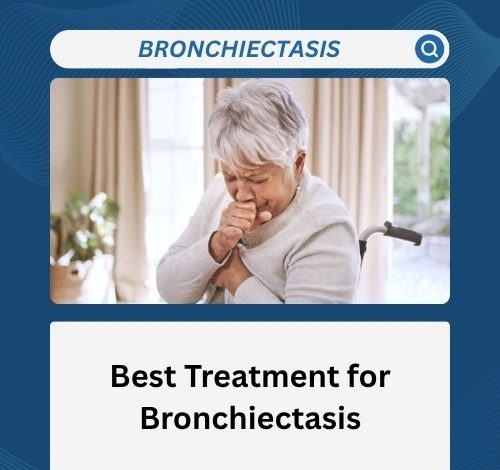Best Treatment for Bronchiectasis: Proven Options That Improve Your Quality of Life

Bronchiectasis is a long-term condition that causes the airways in your lungs to become abnormally widened. This leads to a build-up of mucus, which increases the risk of infections and breathing difficulties. If you’ve been diagnosed, you’re likely asking what is the best treatment for bronchiectasis—and you’re not alone. Thousands of people seek effective strategies each year to manage symptoms, reduce flare-ups, and preserve lung function. The most effective bronchiectasis treatments available today, grounded in clinical evidence and practical outcomes.
Understanding Bronchiectasis and Why Early Treatment Matters
Before exploring treatment for bronchiectasis, it’s essential to recognise what the condition involves. Bronchiectasis occurs when the bronchial tubes become damaged due to repeated infections, inflammation, or other underlying diseases. Over time, the airway walls weaken, and the body struggles to clear mucus, creating a cycle of infection and further damage.
Effective bronchiectasis treatments focus on breaking this cycle—improving airway clearance, treating infections, and preventing further complications. Prompt management can delay progression and significantly enhance your everyday wellbeing.
Related Article: Bronchiectasis Causes, Symptoms, Diagnosis and Treatment

Treatment for Bronchiectasis: A Multi-Faceted Approach
There’s no single cure, but treatment for bronchiectasis combines different methods tailored to the cause and severity of your symptoms. These include:
1. Airway Clearance Techniques
Clearing mucus from your lungs is the cornerstone of any bronchiectasis treatment plan.
- Chest physiotherapy (CPT): This includes postural drainage, percussion, and vibration techniques. Many patients learn to do these at home with guidance from a physiotherapist.
- Positive expiratory pressure (PEP) devices: Tools like the Acapella® or Flutter® help open the airways and shift mucus.
- Active cycle of breathing technique (ACBT): A breathing exercise routine that combines deep breaths and huff coughing to move mucus.
These methods reduce the frequency of infections and help you breathe more easily.
Related Article: Natural Remedies for Bronchiectasis Relief pain with Ginger
2. Inhalation Therapy
Inhaled therapies are often part of the treatment of bronchiectasis:
- Saline Nebulisers: Hypertonic saline solutions (3–7%) thin mucus and make it easier to clear. Regular use helps reduce flare-ups.
- Bronchodilators: Inhalers like salbutamol may be prescribed if you experience wheezing or co-existing asthma/COPD.
- Inhaled corticosteroids: While not standard for all, they may help if you have inflammation or overlapping respiratory conditions.
Antibiotic Use: Preventing and Managing Infections
Repeated infections are a hallmark of this condition. As such, treatments for bronchiectasis often include antibiotics to:
Related Article: Infected Bronchiectasis Treatment and Symptoms
- Treat acute flare-ups
- Prevent recurrent infections
- Suppress chronic infection, particularly with organisms like Pseudomonas aeruginosa
Types of antibiotic use include:
Oral Antibiotics
For mild exacerbations, a 10–14-day course based on sputum culture results is standard.
Intravenous Antibiotics
Required in severe cases or when oral treatments fail. Often administered in hospital or through a home IV service.
Long-term Antibiotics
Low-dose macrolides (e.g., azithromycin) may be prescribed for their anti-inflammatory and immunomodulatory effects in patients with frequent flare-ups.
This approach must be monitored carefully to avoid resistance and side effects.
Related Article: Say Goodbye to Bronchiectasis: Effective Remedies You Must Try
Vaccinations and Prevention
Preventing infections is vital in the treatment of bronchiectasis. Make sure to:
- Stay up-to-date with pneumococcal and influenza vaccines.
- Consider pertussis (whooping cough) and COVID-19 vaccinations, especially if you’re at higher risk.
These simple actions protect your lungs from further insult and help reduce hospital admissions.
Managing Underlying Causes
Sometimes, bronchiectasis is secondary to another condition such as:
- Primary ciliary dyskinesia
- Allergic bronchopulmonary aspergillosis (ABPA)
- Autoimmune diseases
- Immunodeficiency
Addressing the root cause is a key part of the best treatment for bronchiectasis. For example:
- Treating ABPA involves corticosteroids and antifungal medications.
- Immunoglobulin replacement therapy helps if you have antibody deficiency.
If you’ve been searching for what is the best treatment for bronchiectasis, identifying and treating the underlying cause is a major part of the answer.
Related Article: Bronchiectasis Relief in a Bottle? Discover These Powerful Supplements
Pulmonary Rehabilitation
Pulmonary rehab is a structured programme combining exercise training, education, and support. It’s particularly beneficial if you experience breathlessness or frequent fatigue.
Benefits include:
- Improved fitness and lung function
- Reduced shortness of breath
- Better quality of life
A respiratory therapist or physiotherapist can help you tailor a plan suited to your condition and limitations.
Surgery: A Last Resort Option
Surgical treatment is rare and only considered if:
- Bronchiectasis is localised to one lung segment
- Infections are severe and frequent
- Medical treatment has failed
Lobectomy (removal of the affected lung section) may be performed. However, most people respond well to conservative bronchiectasis treatments, and surgery is typically a last resort.
Related Article: Breathe Free Again: 7 Bronchiectasis Remedies You Can Try at Home
Daily Self-Care: What You Can Do at Home
Living with bronchiectasis means being proactive daily. Here’s how you can take control:
1. Hydration
Drinking plenty of water thins mucus, making it easier to clear.
2. Smoking Cessation
If you smoke, stopping is one of the most effective actions to support your lungs.
3. Avoiding Air Pollutants
Stay away from smoke, strong chemical fumes, and dusty environments that can irritate your lungs.
4. Regular Monitoring
Keep a symptom diary, monitor sputum colour/consistency, and report changes to your GP or respiratory specialist.
All these strategies, combined with proper medical care, contribute significantly to the overall treatment for bronchiectasis.
Future Options and Emerging Therapies
Ongoing research is exploring:
- Targeted anti-inflammatory treatments
- Biologic therapies for severe inflammatory subtypes
- Advanced inhaled antibiotics to manage resistant bacteria
While not yet standard, these may change how bronchiectasis treatment is approached in the future. Keeping in touch with your consultant can ensure you benefit from new developments as they become available.
What Is the Best Treatment for Bronchiectasis?
You’ve likely asked this question at some point: what is the best treatment for bronchiectasis?
The answer depends on several factors—your specific cause, symptoms, infection history, and overall lung function. However, the most effective plans usually combine:
- Regular airway clearance
- Appropriate antibiotics
- Prevention through vaccines
- Treatment of underlying conditions
- Supportive care such as rehab and lifestyle changes
While there’s no universal answer, your respiratory team can personalise a strategy that brings results. And by staying informed and involved in your care, you can play an active part in managing your condition.
Alternative Treatment for Bronchiectasis
Alternative Treatment for Bronchiectasis focuses on managing symptoms and improving lung function without relying solely on conventional medications. Many individuals turn to holistic approaches such as herbal supplements, breathing exercises, and dietary changes to support their respiratory health. These methods aim to reduce inflammation, clear mucus, and enhance the immune system. Incorporating therapies like steam inhalation, chest physiotherapy, and acupuncture can also offer additional relief. By addressing the root causes of chronic infection and mucus buildup, alternative treatments provide a more comprehensive and less invasive approach to care.
Bronchiectasis natural remedies often include the use of herbs like turmeric, licorice root, and ginger, which possess anti-inflammatory and antimicrobial properties. These natural solutions help soothe irritated airways and assist in mucus clearance. Regular consumption of antioxidant-rich foods, staying hydrated, and avoiding environmental irritants further supports lung health. When combined with lifestyle changes and proper medical guidance, these natural remedies can play a vital role in managing bronchiectasis symptoms effectively.
Natural Treatment for Bronchiectasis
Natural treatment for bronchiectasis focuses on reducing symptoms, improving lung function, and enhancing quality of life without relying solely on pharmaceutical drugs. This approach includes a combination of dietary changes, breathing exercises, and herbal supplements that help reduce inflammation and support respiratory health. Steam inhalation, chest physiotherapy, and regular hydration are commonly recommended to help loosen mucus and promote easier breathing. Many patients find that adopting a healthy lifestyle with regular exercise and a nutrient-rich diet can significantly support the effectiveness of a natural treatment for bronchiectasis.
Herbal remedies such as turmeric, ginger, and licorice root are often used in bronchiectasis natural treatment due to their anti-inflammatory and expectorant properties. These herbs may help reduce lung irritation and clear mucus from the airways naturally. Additionally, antioxidants from fruits and vegetables can strengthen the immune system, helping the body fight infections that often worsen the condition. While bronchiectasis natural treatment cannot cure the disease, it can be an effective complementary approach to manage symptoms and reduce flare-ups when used under medical supervision.
Final Thoughts
Bronchiectasis may be a chronic condition, but that doesn’t mean your quality of life has to suffer. With the right approach, many people live full, active lives. From airway clearance to antibiotics, vaccinations, and pulmonary rehab, these treatments for bronchiectasis are proven to help reduce flare-ups and protect your lungs.
If you’ve found yourself asking what is the treatment for bronchiectasis, start with a discussion with your GP or specialist and explore the options available to you. With consistent care, education, and support, your lungs can function better—and so can your daily life.




